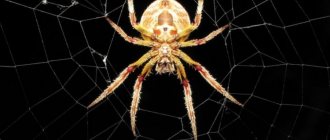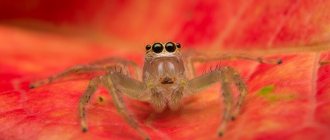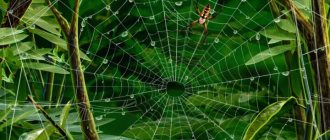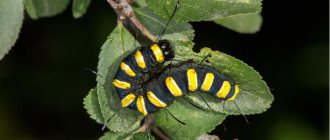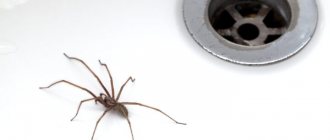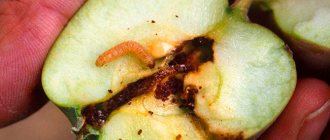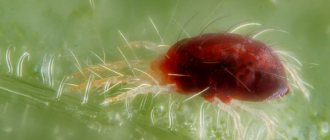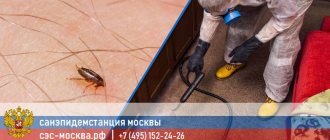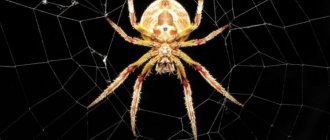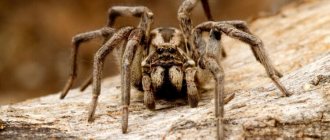Artificial web has caught up with the real one in terms of mechanical properties
Nephila clavipes
Kevin O'Mara / flickr
American biochemists have obtained, in laboratory conditions, threads consisting of record-breakingly long molecules of spidroin, the protein from which spiders weave webs. Using recombinant DNA and protein splicing, scientists obtained a polypeptide with a molecular weight of more than 500 kilodaltons - almost twice as much as similar molecules that are synthesized in nature. From these proteins, scientists obtained threads whose mechanical properties - tensile strength, extensibility and rigidity - are not inferior to spider webs, scientists write in Biomacromolecules
.
Spider web is one of the strongest natural materials: the tensile strength of its threads can reach 1.3 gigapascals (for comparison, the strength of some steel grades does not exceed several hundred megapascals). The main material of the web is two types of proteins: the stronger spidroin I and the more elastic spidroin II. It is almost impossible to reproduce the production of threads from these proteins under artificial conditions: breeding spiders, unlike silkworms, is very difficult, and obtaining such material in laboratory conditions does not yet allow achieving the required mechanical characteristics.
The composition of spidroin is known: the protein consists of a large number of fragments of two types - sections containing only alanine, and sections predominantly consisting of glycine, but including other amino acids. However, when these molecules were obtained in the laboratory, they turned out to be too short, so their mechanical properties were far from natural spidroin.
Diagram of the primary structure of spidroin
BQUB13-Acolom / Wikimedia commons
Share
To increase the length of artificially synthesized spidroin molecules, American biochemists led by Fuzhong Zhang from Washington University in St. Louis proposed the use of recombinant DNA molecules. In these molecules, repeating nucleotide sequences are artificially created that are responsible for the synthesis of the correct sections of the protein, and during translation, a recombinant protein of increased length is synthesized. Thanks to this approach, it was already possible to synthesize recombinant spidroin, but the maximum mass of the molecules obtained in this way did not exceed 285 kilodaltons (for comparison, the molecular weight of natural spidroin is about 310 kilodaltons).
To increase the molecular weight of the synthesized protein, scientists slightly modified this technique: after translation of the recombinant protein, its molecular weight was increased using the splicing technique. In this approach, an internal fragment—intein—is cut out of the molecule, and terminal protein sequences are added in place of the cuts. Inteins can connect to each other, so if one protein molecule is “cut” at the N-terminus and another at the C-terminus, and then join them together, the molecular weight of the protein can actually be doubled.
The resulting spidroin filaments
Christopher Bowen
Share
Microphotograph of a section of one thread. Scale bar - 5 micrometers
Christopher H. Bowen et al./ Biomacromolecules, 2018
Share
Using the proposed approach, scientists synthesized spidroin based on DNA isolated from spiders of the species
Nephila clavipes
, the mass of which was immediately increased to 556 kilodaltons - this protein contains 192 repeating regions of spidroin. From these protein chains, scientists obtained threads with a diameter of several micrometers, which in their mechanical properties were not inferior to natural fibers in the web. The tensile strength of the threads was 1.03 gigapascals, the elastic modulus was 13.7 gigapascals, the elongation was 18 percent, and the stiffness was 114 megajoules per cubic meter. In addition, the mechanical properties of the resulting materials turned out to be directly related to the molecular weight of the protein - the more amino acids a molecule includes, the stronger the thread consisting of these proteins will be. Previously, this pattern could only be demonstrated for relatively short proteins.
According to the authors of the study, the resulting fibers can already be used in applications that require the use of especially strong micrometer-thick filaments. In addition, in the future, using a similar approach, other types of natural materials can be quite easily obtained in the laboratory.
It is worth noting that to obtain similar super-strong threads, only spider web and silk proteins are not always used. For example, Swedish chemists recently synthesized an artificial analogue of spider web thread, which consists of only ten percent spider protein, and the remaining 90 percent is cellulose nanofibers derived from wood. Fibroin, a protein found in silk, is also used to produce other types of composite materials. Thus, by combining it with silicone, American materials scientists created a material capable of changing its magnetic properties when heated by light.
Alexander Dubov
How spiders make webs
A large number of arachnoid glands are located in the abdominal cavity of the spider . The ducts of such glands open into tiny spinning tubes that have access to the end part of special arachnoid warts. The number of spinning tubes may vary depending on the type of spider. For example, the very common cross spider has five hundred of them.
This is interesting! The arachnoid glands produce a liquid and viscous protein secretion, the peculiarity of which is the ability to almost instantly harden under the influence of air and turn into thin long threads.
The process of spinning a web involves pressing the spider warts onto a substrate. The first, insignificant part of the released secretion hardens and reliably sticks to the substrate, after which the spider pulls out the viscous secretion using its hind legs. In the process of removing the spider from the site of attachment of the web, the protein secretion stretches and quickly hardens. Today, seven different types of arachnoid glands, which produce different types of threads, are known and fairly well studied.
Return to content
Elasticity of the web
To find out the properties of the web, I conducted six experiments. Observations of the web, collection of experimental material - the web was carried out in the period from August 1 to August 30, 2016 in the city of Taganrog and its environs.
The purpose of the first experiment was to study the elasticity of the web (Appendix).
In the experiment, I used a ruler, a web (the diameter of the web is 22 cm, the network has 15 circles), and a camera.
Progress of the experiment. I carefully brought a ruler close to the web (the diameter of the web in its original position is 22 cm). He moved the branches on which the web is attached to the sides:
— stretched the web by 1 cm and released the branches - the web returned to its original position: its diameter did not change, the threads of the web remained taut, as before stretching;
- stretched the web by 2 cm and stretched the branches - the web returned to its original position: its diameter did not change, the threads of the web remained taut;
- I stretched the web by 3 cm - the web broke.
Conclusion: the web is elastic and does not deform; under increased pressure it breaks (has a tensile strength).
Literature
- "Smart" glue from spider webs;
- Agapova O.I., Efimov A.E., Moisenovich M.M., Bogush V.G., Agapov I.I. (2015). Comparative analysis of the three-dimensional nanostructure of porous biodegradable matrices from recombinant spidroin and silk fibroin for regenerative medicine. Bulletin of transplantology and artificial organs. XVII , 37–44;
- Golden Spider Silk. Victoria and Albert Museum website, 2012;
- Yaqub E. (2001). Defeating Athena. Science and life. No. 2;
- Kotlyar P. (2015). A startup weaves a web. Website "Gazeta.ru";
- Archaea are “rude” and help;
- Spider invasion in Australia. Website "Day X", 2013;
- Kirsanov G.P. (1974). Nutrient medium for feeding spiders. Website FindPatent.ru;
- Rudy Y. (2009). Madagascars have created the largest spider silk fabric. Membrane website;
- A cape made from spider silk will be exhibited at an exhibition in Europe. Website GlobalScience.ru, 2012;
- Technology platform “Medicine of the Future”. Website of the Eurasian Economic Commission, 2012;
- Aksenova L. (2013). Spiders will help you forget about pain. Website "Gazeta.ru";
- The great combinator never dreamed of: the combinatorics of spider toxins.
The influence of ambient temperature on the web
The purpose of the second experiment was to study the reaction of the web to changes in ambient temperature (Appendix).
During the experiment, I used a plastic tightly closed container, branches with cobwebs, a refrigerator, and a thermometer.
Procedure of the experiment: I placed branches with cobwebs in a plastic tightly closed container and placed them in the freezer of the refrigerator for 24 hours. The air temperature in the freezer is minus 18ºС. After 24 hours, the appearance of the web did not change: its color remained the same, frost did not appear on the webs, it was not cold to the touch and remained sticky, the elastic properties of the web were preserved.
I placed new branches with cobwebs in one plastic tightly closed container, and in another identical container - branches with cobwebs that had just been removed from the freezer. The containers were placed in the sun (average air temperature - plus 30ºС) for 24 hours. After 24 hours, the appearance of the web did not change: its color remained the same, it was not warm to the touch and remained sticky, the elastic properties of the web were preserved, and no additional odor appeared in the plastic container with the web.
Conclusion: the appearance of the web, its quality and properties are not affected by high and low temperatures, as well as sudden changes in air temperature.
Functions of the web and its purpose
Webs are used by spiders for a variety of purposes. A shelter woven from a strong and reliable web allows you to create the most favorable microclimatic conditions for arthropods, and also serves as a good shelter both from bad weather and from numerous natural enemies. Many arthropod arachnids are capable of weaving their web around the walls of their burrow or making it into a kind of door into their home.
This is interesting! Some species use webs as transport, and young spiders leave the parental nest on long web threads, which are picked up by the wind and transported over considerable distances.
Most often, spiders use webs to weave sticky trapping networks, which allows them to effectively catch prey and provide food to the arthropod. No less famous are the so-called egg cocoons made from webs, inside which young spiders appear . Some species weave web-like safety threads that protect arthropods from falling while jumping and for moving or catching prey.
Web for reproduction
The breeding season is characterized by the release of arachnoid threads by the female, which make it possible to find the optimal pair for mating. For example, male web-slingers are capable of constructing, next to the nets created by females, miniature mating web laces into which spiders are lured.
Male cross spiders deftly attach their horizontal webs to radially arranged strands of trapping webs made by females. By striking the web with strong blows with their limbs, the males cause the web to vibrate and, in this unusual way, invite the females to mate.
Web for catching prey
In order to catch their prey, many species of spiders weave special trapping nets, but some species are characterized by the use of peculiar web lassos and threads. Spiders that hide in burrow dwellings place signal threads that stretch from the arthropod’s abdomen to the very entrance to its shelter. When prey falls into the trap, the vibration of the signal thread is instantly transmitted to the spider.
Sticky spiral trapping nets are built on a slightly different principle . When creating it, the spider begins weaving from the edge and gradually moves towards the central part. In this case, the same gap between all turns is necessarily maintained, resulting in the so-called “Archimedes spiral”. The threads on the auxiliary spiral are specially bitten by the spider.
Web for insurance
Jumping spiders use web threads as insurance when attacking a victim. Spiders attach a safety thread of the web to any object, after which the arthropod jumps on the intended prey. The same thread, attached to the substrate, is used for overnight shelter and protects the arthropod from attacks by all kinds of natural enemies.
This is interesting! South Russian tarantulas, leaving their burrow home, pull behind them a thin web thread, which allows them to quickly find the way back or the entrance to the shelter if necessary.
Web as transport
By autumn, some species of spiders hatch their young. Young spiders that survive the process of growing up try to climb as high as possible, using trees, tall bushes, roofs of houses and other buildings, fences for this purpose. Having waited for a sufficiently strong wind, the small spider releases a thin and long web.
The distance of movement directly depends on the length of such a transport web. Having waited for a good tension of the web, the spider bites off its end and takes off very quickly. As a rule, “travelers” are able to fly several kilometers on a web.
Silver spiders use webs as water transport. To hunt in bodies of water, this spider requires breathing atmospheric air. When descending to the bottom, the arthropod is able to capture a portion of air, and on aquatic plants, a kind of air bell is constructed from the web, which retains air and allows the spider to hunt its prey.
Return to content
Research on the strength of the web
The purpose of the fifth experiment was to test the strength of the web (Appendix).
During the experiment, I used a ruler, fishing weights weighing 2 g, 5 g and 10 g and a spider web.
I chose one thread from the web: length 21 cm. The thread is very thin, less than 1 mm. I pulled the spider's thread and it broke.
Gradually I folded 10 cobwebs and got one: length 12 cm, thickness 0.5 mm. A load weighing 2 hectares was tied to such a “rope” - the “rope” did not break. I tied a load weighing 5 g - the “rope” broke.
Gradually I put together 46 cobwebs and got one: length 9 cm, thickness 1 mm. I tied a load weighing 2 hectares to the “rope” - the “rope” did not break. I tied a load weighing 5 g - the “rope” did not break. I tied a 10 g weight to the “rope” - the “rope” broke.
Conclusion: the strength of the web increases with the number of webs.
Burning web
The purpose of the fourth experiment was to study the characteristics of the combustion of spider webs (Appendix).
During the experiment, I used a metal rod with a web and matches.
I learned from adults that artificial polymer fabrics always melt when burned and often emit strong, unpleasant odors. If you set fire to a large piece of synthetic fabric, rubber or fishing line, its edges will seem to melt and even flow down in hot drops, and black smoke will be released. The burning of natural fabric differs from the burning of artificial fabric.
I set fire to the web and it caught fire. The flame is red in the middle, blue at the edges, without emitting black smoke. When burning, there is a pungent odor of burnt feathers.
Conclusion: the web burns, does not melt. This means it is of natural origin.
